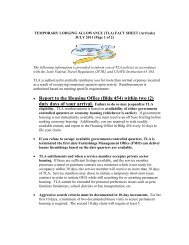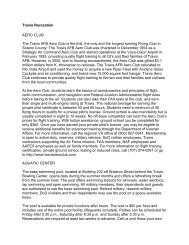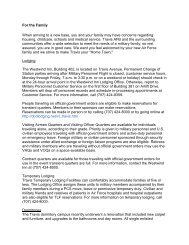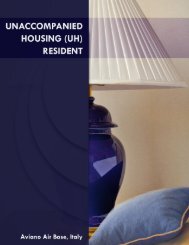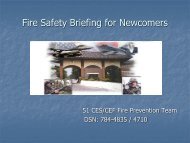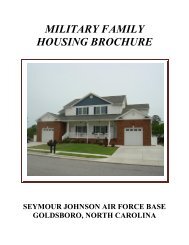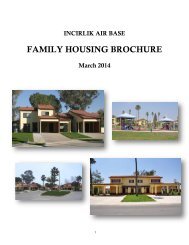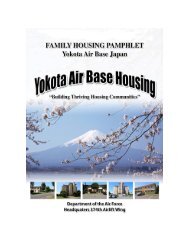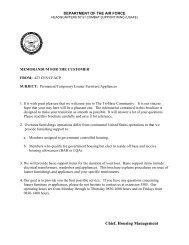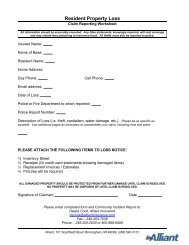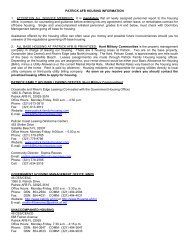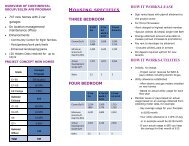San Antonio Military Telephone Directory - Air Force Housing
San Antonio Military Telephone Directory - Air Force Housing
San Antonio Military Telephone Directory - Air Force Housing
You also want an ePaper? Increase the reach of your titles
YUMPU automatically turns print PDFs into web optimized ePapers that Google loves.
Randolph <strong>Air</strong> <strong>Force</strong> Base<br />
COMMErcial OPErator SErvicES<br />
1. The base is charged for all commercial operator-handled<br />
assistance calls. Calls for the following services<br />
are not authorized except in the event of a bonafide<br />
emergency:<br />
a. Verify conversation on a busy commercial line<br />
($1.35).<br />
b. Interrupt conversation on a busy commercial line<br />
($2.20).<br />
c. Local operator assistance ($1.30).<br />
2. Authorized assistance calls for commercial operator<br />
services must be placed via the base operator, and<br />
reported to the TCO as soon as possible to have the<br />
call logged on AF Form 1072.<br />
THE DEFENSE SwitchED NEtwork<br />
(DSN) SYSTEM<br />
1. GENERAL. The DSN Network is the principle longhaul,<br />
voice communications network within the Defense<br />
Communications System, providing unsecure direct<br />
distance dialing service worldwide through a system<br />
of Government-owned and leased automatic witching<br />
facilities. The purpose of DSN is to handle command<br />
and control, operations, intelligence, logistics, diplomatic,<br />
and administrative traffic.<br />
2. PreceDence. The Joint Uniform <strong>Telephone</strong> Communications<br />
Precedence System is directed for use by<br />
all authorized users of voice communications facilities<br />
of the Department of Defense (DoD). It established a<br />
FLASH OVERRIDE capability, and the precedence<br />
designators of ROUTINE, PRIORITY, FLASH,<br />
IMMEDIATE. Precedence is the calling capability<br />
assigned to a DSN user terminal. Since the effectiveness<br />
of the system depends upon the cooperation of<br />
the persons authorized to use it, users must be familiar<br />
with the purpose of each precedence category and the<br />
types of calls assigned the respective precedence.<br />
a. POLicY ON THE USE OF THE TELEPHone<br />
PreceDence SYstem.<br />
1. FLasH. Reserved for alerts, warnings or other<br />
emergency actions having immediate bearing on<br />
national, command or area security.<br />
2. IMMEDIATE. Reserved for vital communications:<br />
a. Having an immediate affect on tactical<br />
operations.<br />
b. Directly concerning safety or rescue operations.<br />
c. Affecting the intelligence community operational<br />
role.<br />
3. PrioritY. Reserved for calls requiring prompt<br />
completion for national defense and security, the<br />
successful conduct of war, or safeguarding life or<br />
property, but do not require higher precedence.<br />
Normally, PRIORITY is the highest precedence that<br />
may be assigned to administrative matters for which<br />
speed of handling is of paramount importance.<br />
4. ROUTINE. Reserved for all other official office<br />
communications.<br />
b. use OF Dsn. Users are responsible for the proper<br />
use and control of DSN lines. Everyone’s cooperation<br />
will ensure better service and a higher completion<br />
rate of DSN calls, particularly those to international<br />
locations.<br />
1. DSN is authorized for official communications only.<br />
2. DSN is restricted to only those calls that are<br />
essential, requiring a timeliness that cannot be<br />
obtained by other means, and would stand the<br />
scrutiny afforded a commercial toll call.<br />
3. Precedence level used will be consistent with<br />
the subject matter of the call as established in<br />
the Joint Uniform <strong>Telephone</strong> Communications<br />
Precedence System.<br />
a. DSN users will use the lowest precedence<br />
consistent with the operational mission or<br />
necessity for each call placed. Don’t request<br />
or use a precedence higher than required.<br />
b. The assignment or use of a precedence designator<br />
based solely on rank or duty position is<br />
strictly prohibited.<br />
4. Voice-data, facsimile, and graphic service in DSN<br />
will normally not exceed a continuous transmission<br />
time of 15 minutes nor total transmission of<br />
1 hour during normal business hours.<br />
5. Off-net extension of calls into the commercial<br />
system at a distant PBX/PABX is encouraged<br />
where such extension has been previously<br />
approved by the local authorities controlling the<br />
switchboard.<br />
6. Calls will be limited to the minimum time required<br />
to accomplish official business, normally not to<br />
exceed 5 minutes.<br />
7. Calls of all DSN users, except those of certain<br />
National Command Authorities and Unified and<br />
Specified Commanders, are subject to preemption<br />
by calls of higher precedence. Preemption is<br />
the act of seizing the line from a lower precedence<br />
call to support higher precedence calls, and is<br />
automatically and randomly executed in the telephone<br />
switching equipment.<br />
8. DSN will not be authorized for:<br />
a. Use directly or indirectly by any non-appropriated<br />
funds activities (clubs, exchange, and<br />
other unofficial activities) provided telephone<br />
service at base level except when approved by<br />
the Joint Chiefs of Staff.<br />
b. Unofficial or personal call.<br />
c. Calls within an installation, metropolitan area,<br />
or those confined geographical areas where<br />
other existing Government-provided local<br />
telephone service is adequate.<br />
9. <strong>Telephone</strong> Monitoring. DSN is for official use<br />
only and is subject to authorized monitoring<br />
(AFI 33-219).<br />
DSN USER CALLING INStructionS<br />
1. ROUTINE DSN CALLS<br />
a. Users with direct-dial access to DSN should:<br />
1. Verify the DSN number.<br />
2. Listen for a dial tone.<br />
3. Dial the DSN access code 94. (NOTE: You will not<br />
hear a dial tone after dialing the access code.)<br />
4. Dial the 7-digit DSN number.<br />
b. Users with operator-access to DSN should:<br />
1. Verify the DSN number.<br />
2. Dial “0” and give the following information to the<br />
switchboard attendant:<br />
a. Your name and extension number.<br />
b. The DSN number desired (including country<br />
code for international locations).<br />
c. Remain on the line while the attendant completes<br />
the call.<br />
DSN USER ASSIStancE<br />
Call assistance, conferencing, and directory assistance for<br />
DSN users are provided by dialing “0.”<br />
DSN USER TROUBLE REporting<br />
When users encounter trouble while utilizing DSN, use the<br />
following procedures:<br />
1. Retain the circuit connection and on another phone,<br />
report the trouble immediately to the HELP desk,<br />
652-2015 opt. 1.<br />
2. Give the details of the DSN trouble as follows:<br />
a. Your extension number and location.<br />
b. The DSN number and locations of the called party.<br />
c. A brief description of the trouble and the time it<br />
occurred.<br />
DIGITAL TELEphonE Switching<br />
The DMS-100 digital switching system at Randolph AFB<br />
is designed to make it easier for you to carry out your job<br />
responsibilities. With the features this system provides,<br />
your telephone is capable of many sophisticated operations<br />
such as speed calling, setting up conference calls, and<br />
forwarding calls to another extension. The features on your<br />
telephone have been selected to reflect your specific telephone<br />
needs. With the exception of telephones coded for<br />
data use only, P-phones, and some electronic key systems,<br />
all base extensions are equipped with three basic features:<br />
call transfer, consultation hold, and 3-way calling. Electronic<br />
key system and P-Phone users should refer to their<br />
user guides for special feature operating instructions. For<br />
information about the features assigned to your instrument,<br />
call the HELP desk, 652-2015 opt. 1. Submit requests to<br />
add or delete features to your telephone, on AF Form 3215,<br />
C-4 Systems Requirements Document, through your TCO<br />
to 902 CS/SCXPR. All requests for features other than the<br />
basics must be adequately justified.<br />
1. caLL TRANSFer.<br />
a. Briefly depress and release switch-hook once.<br />
b. Listen for stutter dial tone.<br />
c. Dial the extension.<br />
d. Hang up (calls cannot be transferred off-base<br />
without special features).<br />
2. CONSULtation HOLD.<br />
a. To consult with another party and exclude the<br />
original party:<br />
1. Briefly depress and release switch-hook once.<br />
2. Listen for stutter dial tone.<br />
3. Dial the extension.<br />
4. Consult BRIEFLY.<br />
5. Wait for called party to hang up.<br />
b. To return to the original party, depress and release<br />
switch-hook ONCE.<br />
3. 3-WAY CALLinG.<br />
a. To add another party to a call in progress:<br />
1. Briefly depress and release switch-hook once.<br />
2. Listen for stutter dial tone.<br />
3. Dial the extension to be added.<br />
4. Briefly depress and release switch-hook once to<br />
establish a three-way conversation.<br />
b. One party can hang up, leaving a two-way<br />
conversation.<br />
4. Permanent HOLD.<br />
a. To hold an existing call:<br />
1. Briefly depress and release switch-hook once.<br />
2. Listen for stutter tone.<br />
78 2012/2013 Joint Base <strong>San</strong> <strong>Antonio</strong>




